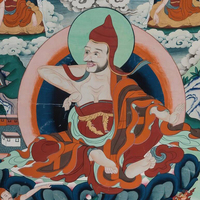
Dharmakirti
Dharmakirti (Chos-kyi grags-pa, Skt. Dharmakīrti) was born to a brahmin family in South India in either the 6th or the 7th century, his dates are uncertain. It is said that when he was young, he was spoken to abusively by his uncle, Kumarīla Bhaṭṭa, a prominent scholar of the non-Buddhist Mīmāṃsā school, which led him to renounce his heritage and take Buddhist robes. He entered Nalanda and, according to Tibetan sources, was ordained there by the Chittamatra scholar Dharmapāla, under whom he purportedly studied.
Based on his bad experience with his uncle, he resolved to refute the non-Buddhist views of his time and made great efforts to learn their assertions and master logic and debate. Nalanda, as one of the greatest monastic universities of the time, offered the ideal environment in which to debate with scholars of these other traditions, many of whom taught there. An additional incentive in these debates was to win royal patronage for the followers of the victorious views.
Dharmakirti’s main contributions to the development of Indian Buddhism were in the fields of epistemology, logic, and Sautrantika and Chittamatra metaphysics. He based his study of valid cognition on Dignaga’s Compendium of Validly Cognizing Minds (Tshad-ma kun-btus, Skt. Pramāṇasamuccaya) and developed its presentation further in his magnum opus, Commentary on (Dignaga’s “Compendium of) Validly Cognizing Minds” (Tshad-ma rnam-'grel, Skt. Pramāṇavārttika), where he elaborated on the main features shared in common by the Sautrantika and Chittamatra Followers of Reason (rigs-pa rjes-su ‘brang-ba). In it, he demonstrated the effectiveness of logic in proving the existence of past and future lives and the authority of the Buddha as a valid source of information. This text became the cornerstone for the study of valid cognition in the standard curriculum for the Geshe and Khenpo degrees in all Tibetan Buddhist traditions. His Autocommentary on this celebrated text (Tshad-ma rnam-‘grel-gyi ‘grel-ba, Skt. Pramāṇavārttikavṛtti) has survived in the original Sanskrit just for the first chapter and in Tibetan translation just for the first two chapters.
Dharmakirti wrote several other important texts:
- Ascertainment of Validly Cognizing Minds (Tshad-ma rnam-par nges-pa, Skt. Pramāṇaviniścaya)
- A Discussion Called “A Drop of Logic” (Rigs-pa’i thigs-pa zhes-bya-ba’i rab-tu byed-pa, Skt. Nyāyabindunāmaprakaraṇa)
- A Discussion Called “A Drop of Reasons” (gTan-tshigs-kyi thigs-pa zhes-bya-ba’i rab-tu byed-pa, Skt. Hetubindunāmaprakaraṇa)
- A Discussion (Called) “An Analysis of Relations” ('Brel-pa brtag-pa'i rab-tu byed-pa, Skt. Sambandhaparīkṣāprakaraṇa)
- Autocommentary on (“A Discussion Called) ‘An Analysis of Relations’” ('Brel-pa brtag-pa'i ‘grel-ba, Skt. Sambandhaparīkṣāvṛtti)
- A Discussion Called “Logic for Debate” (rTsod-pa’i rigs-pa zhes-bya-ba’i rab-tu byed-pa, Skt. Vādanyāyanāmaprakaraṇa)
- A Discussion Called “Proof of Other’ Mental Continuums” (rGyud-gzhan grub-pa zhes-bya-ba’i rab-tu byed-pa, Skt. Saṃtānāntarasiddhināmaprakaraṇa).
Two main schools of interpretation of his works on valid cognition evolved in Tibet from the commentaries by
- Chapa Chokyi Senge (Phyva-pa Chos-kyi seng-ge)
- Sakya Pandita (Sa-pan Kun-dga' rgyal-mtshan).
The Gelug tradition follows the former, which is the True Aspectarian (rnam-bden-pa) interpretation. It asserts that the objects of sensory cognition are the commonsense objects of the everyday world. They are established as existing in the way in which they appear.
The Sakya and Nyingma traditions follow the latter, which is the False Aspectarian (rnam-brtsun-ma) interpretation. It asserts that the objects of sensory cognition are not established in the way in which they appear. They are conceptual constructs interpolated on momentary sensibilia – sights, sounds, smells, tastes and physical sensations.